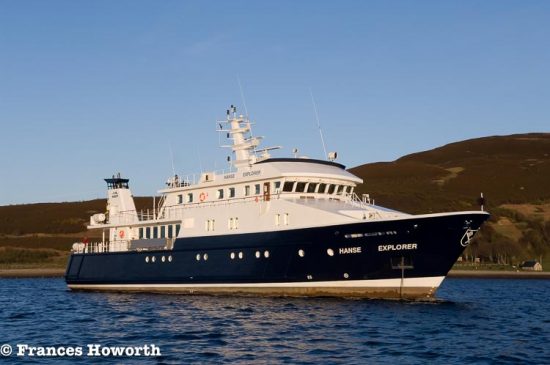
Fraser Yachts has added Hanse Explorer to their sales fleet with an asking price of €13,500,000.
A true adventure yacht, she is the only purpose built ice class expedition yacht on today’s market but she will need a refit if superyacht standards of accommodation are required
The 48-metre yacht, was built originally to train professional seamen, including officers, engineers and chefs, whilst simultaneously offering up to 12 passengers the opportunity to experience a very different kind of luxury adventure.
The idea was to allow passengers to participate as much as they wish in day-to-day life on board a luxury yacht – from ship navigation and itinerary planning to learning; how to make soup in a Force 12 gale.
Ship owner and businessman, Peter Harren, was the man behind this new concept in expedition cruising and, in November 2004, Fassmer, a German ship-building company specialising in navy and high speed vessels, was commissioned with her development, design and build.
Harren had identified what he saw as a major problem in the shipping industry; they were not seeing the same growth pattern in the levels of well-trained staff as they were in the number of new ships being constructed.
As the owner of almost 40 vessels, Harren is well aware of the contribution a well-trained crew can make, not only towards the smooth running of a ship but also the safety and service on board and ultimately the costs.
His solution to the problem involved designing and building a brand new luxury vessel with the aim of actively supporting the training of professional seamen, whilst at the same time offering up to 12 passengers the opportunity to experience a very different luxury adventure.
Hanse Explorer was designed and built to the highest specification with a view to operating ‘real’ expeditions. With a length of 48 metres, a shallow draft of 4.40 metres and an E3 ice-class, she can sail and land in areas where many vessels, other than private yachts, cannot.
When we sailed in the vessel, guests are encouraged to be actively involved in the day to day schedule planning and, subject to wind, weather and ice conditions, the decision of ‘where to go tomorrow’ will be taken together with the guests.
The vessel carries two Zodiacs, which depending on the itinerary, are used for landings and also cruising around small bays and islands, as well as amongst the magnificent icebergs of Antarctica and the Arctic.
The vessel carried up to 12 passengers. All of the six interior designed guest cabins are tastefully fitted to a good passenger ship standard and come complete with powerful rain shower systems in the en-suite bathrooms and the most up to date electronics equipment including satellite phone and a large flat screen, ideal for working on digital photographs. The accommodation for the 12 trainees and six crew members was also of an unusually high standard.
Officially launched at the end of 2006; she spent her first season in Ireland and Scotland, sailing up to the Arctic for the summer months on voyages that include Spitsbergen, Iceland and Greenland, before moving down the east coast of the USA to Central and South America and then on to the Antarctic Peninsula, the Falkland Islands and South Georgia (hence the requirement for the ice-class specification).
The future potential opportunities for use of the vessel are many and varied: WWF Germany chartered her in 2008 to visit their South American conservation projects but she will need working on!
